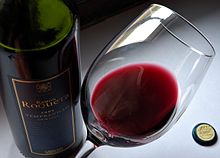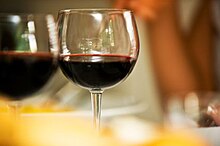Health effects of wine


The health effects of wine are mainly determined by its active ingredient –
Drinking more than the standard drink amount increases the risk of
Risk is greater in young people due to
The
Moderate consumption

Nearly all research into the positive medical benefits of wine consumption makes a distinction between moderate consumption and heavy or binge drinking.[3] Moderate levels of consumption vary by the individual according to age, sex, genetics, weight and body stature, as well as situational conditions, such as food consumption or use of drugs.[3] In general, women absorb alcohol more quickly than men due to their lower body water content, so their moderate levels of consumption may be lower than those for a male of equal age.[13]: 341–2 Some experts define "moderate consumption" as less than one 5-US-fluid-ounce (150 ml) glass of wine per day for women and two glasses per day for men.[3][14]
The view of consuming wine in moderation has a history recorded as early as the Greek poet
Three bowls do I mix for the temperate: one to health, which they empty first, the second to love and pleasure, the third to sleep. When this bowl is drunk up, wise guests go home. The fourth bowl is ours no longer, but belongs to violence; the fifth to uproar, the sixth to drunken revel, the seventh to black eyes, the eighth is the policeman's, the ninth belongs to biliousness, and the tenth to madness and hurling the furniture.[16]
Emerging evidence suggests that "even drinking within the recommended limits may increase the overall risk of death from various causes".[17] A 2018 systematic analysis found that "The level of alcohol consumption that minimised harm across health outcomes was zero (95% UI 0·0–0·8) standard drinks per week".[18] On the other hand, a 2020 USDA systematic review found that "low average consumption was associated with lower risk of mortality compared with never drinking status".[19] As of 2022, "moderate" consumption is usually defined in average consumption per day while the patterns of consumption vary and may have implications for risks and effects on health (such as habituation from daily consumption or nonlinear dosage-harm associations from intermittent excessive alcohol use). According to the CDC, it would be important to focus on the amount people drink on the days that they drink.[17]
Effect on the body
Bones
Heavy alcohol consumption has been shown to have a damaging effect on the cellular processes that create
Cancer
The
Cardiovascular system
Professional cardiology associations recommend that people who are currently nondrinkers should abstain from drinking alcohol.]
The alcohol in wine has anticoagulant properties that may limit blood clotting.[23]
Digestive system
The risk of infection from the bacterium
Headaches
There are several potential causes of so-called "red wine headaches", including
Food intake

Alcohol can stimulate the appetite so it is better to drink it with food. When alcohol is mixed with food, it can slow the stomach's emptying time and potentially decrease the amount of food consumed at the meal.[28]
A 150-millilitre (5-US-fluid-ounce) serving of red or white wine provides about 500 to 540 kilojoules (120 to 130 kilocalories) of food energy, while dessert wines provide more.[29] Most wines have an alcohol by volume (ABV) percentage of about 11%; the higher the ABV, the higher the energy content of a wine.[29]
Psychological and social
Danish epidemiological studies suggest that a number of psychological health benefits are associated with drinking wine. In a study testing this idea, Mortensen et al. (2001) measured socioeconomic status, education,
However, more research should be conducted as to the relationship between wine consumption and IQ along with the apparent correlations between beer drinkers and wine drinkers and how they are different psychologically. The study conducted by Mortensen should not be read as gospel. Wine and Beer being an indicator of a person's IQ level should be viewed with a very cautious lens. This study, from what we know, does not take into account the genetic, prenatal and environmental influences of how a person's generalized intelligence is formed. In current scientific literature, it is still a matter of debate and discovery as to what are true and reliable indicators of intelligence. Regular wine consumption being an indicator of higher intelligence while beer being an indicator of low intelligence according to Mortensen et al. (2009) should be looked at with a very critical lens. There should be future research into the validity of whether or not individuals who regularly consume wine have higher IQ scores in comparison to those who drink beer.[30]
Heavy metals
In 2008, researchers from
The researchers stressed that a single glass of wine would not lead to metal poisoning, pointing out that their THQ calculations were based on the average person drinking one-third of a bottle of wine (250 ml) every day between the ages of 18 and 80. However the "combined THQ values" for metal ions in the red wine they analyzed were reported to be as high as 125.
The findings sparked immediate controversy due to several issues: the study's reliance on secondary data; the assumption that all wines contributing to that data were representative of the countries stated; and the grouping together of poorly understood high-concentration ions, such as vanadium, with relatively low-level, common ions such as copper and manganese. Some publications pointed out that the lack of identifiable wines and grape varieties, specific producers or even wine regions, provided only misleading generalizations that should not be relied upon in choosing wines.[35][36]
In a news bulletin following the widespread reporting of the findings, the UK's National Health Service (NHS) were also concerned that "the way the researchers added together hazards from different metals to produce a final score for individual wines may not be particularly meaningful".[36] Commentators in the US questioned the relevance of seafood-based THQ assessments to agricultural produce, with the TTB, responsible for testing imports for metal ion contamination, have not detected an increased risk. George Solas, quality assessor for the Canadian Liquor Control Board of Ontario (LCBO) claimed that the levels of heavy metal contamination reported were within the permitted levels for drinking water in tested reservoirs.[35]
Whereas the NHS also described calls for improved wine labeling as an "extreme response" to research which provided "few solid answers", they acknowledged the authors call for further research to investigate wine production, including the influence that grape variety, soil type, geographical region, insecticides, containment vessels and seasonal variations may have on metal ion uptake.[36]
Chemical composition
Natural phenols and polyphenols
Although red wine contains many chemicals under
Resveratrol
Red wine contains an average of 1.9 (±1.7) mg of trans-resveratrol per liter.[39] For comparison, dietary supplements of resveratrol (trans-resveratrol content varies) may contain as much as 500 mg.[40][41]
Resveratrol is a stilbenoid phenolic compound found in wine produced in the grape skins and leaves of grape vines.[13]: 569
The production and concentration of resveratrol is not equal among all the varieties of
Although red wine and white vine varieties produce similar amounts of resveratrol, red wine contains more than white, since red wines are produced by
Anthocyanins
Red grapes are high in
Typical concentrations of free anthocyanins in full-bodied young red wines are around 500 mg per liter.
Following dietary ingestion, anthocyanins undergo rapid and extensive metabolism that makes the biological effects presumed from in vitro studies unlikely to apply in vivo.[38][46]
Although anthocyanins are under
History of wine in medicine
Early medicine was intimately tied with
Early history


When the Greeks introduced a more systematized approach to medicine, wine retained its prominent role. The Greek physician Hippocrates considered wine a part of a healthy diet, and advocated its use as a disinfectant for wounds, as well as a medium in which to mix other drugs for consumption by the patient. He also prescribed wine as a cure for various ailments ranging from diarrhea and lethargy to pain during childbirth.[13]: 433
The medical practices of the
Religion still played a significant role in promoting wine's use for health. The Jewish
Risks of consumption
The lack of safe
Throughout the mid to early 20th century, health advocates pointed to the risk of alcohol consumption and the role it played in a variety of ailments such as
French paradox
The hypothesis of the
References
- PMID 9420448.
- ^ PMID 25974696.
- ^ PMID 24582196.
- PMID 26997174.
- ^ PMID 23104725.
- PMID 22910838.
- ^ PMID 23642930.
- PMID 29112463.
Clearly, the greatest cancer risks are concentrated in the heavy and moderate drinker categories. Nevertheless, some cancer risk persists even at low levels of consumption. A meta-analysis that focused solely on cancer risks associated with drinking one drink or fewer per day observed that this level of alcohol consumption was still associated with some elevated risk for squamous cell carcinoma of the esophagus (sRR, 1.30; 95% CI, 1.09 to 1.56), oropharyngeal cancer (sRR, 1.17; 95% CI, 1.06 to 1.29), and breast cancer (sRR, 1.05; 95% CI, 1.02 to 1.08), but no discernable associations were seen for cancers of the colorectum, larynx, and liver.
- ^ "Alcohol Facts and Statistics". Retrieved 9 May 2015.
- S2CID 205116954.
- ^ a b "Alcohol and Heart Health". American Heart Association. 2016. Retrieved 12 December 2016.
- ^ ISBN 978-0-307-34635-3.
- ^ ISBN 978-0-19-860990-2.
- ^ Shuman TC, ed. (October 1, 2005). "Alcohol and Heart disease". WebMD.
- ISBN 978-0-671-68702-1.
- ^ Eubulus. Semele or Dionysus, fr. 93.
- ^ a b "Facts about moderate drinking | CDC". CDC. 19 April 2022. Retrieved 24 April 2022.
- PMID 30146330.
- PMID 35353467.
- S2CID 12292033.
- PMID 22456655.
- ISBN 978-92-832-1244-7.
- .
- PMID 10230827.
- S2CID 30825790.
- ^ a b c "Ask the doctor: What causes red wine headaches?". Harvard Health Publishing, Harvard Medical School. 2019. Archived from the original on 25 July 2019. Retrieved 15 May 2019.
- S2CID 20870984.
- ^ Zelman KM (January 26, 2005). "Wine: How Much Is Good for You?". WebMD.
- ^ a b Hughes L (22 March 2017). "How Many Calories Are in Your Wine?". WebMD. Retrieved 15 May 2019.
- PMID 11493125.
- ^ The sample wine was declared to be "a Shiraz from Southeast Australia", although no specific vintage, producer or wine region was stated in the report.
- ^ PMID 18578877.
- PMID 16227070.
- PMID 18973648.
- ^ a b Study of Wine's Heavy Metal Hazard Raises Doubts Among Other Experts Wine Spectator, November 2008
- ^ a b c Metal in wine Archived 2012-10-07 at the Wayback Machine, UK NHS news bulletin, October 2008
- .
- ^ a b c d Gross P (March 1, 2009), New Roles for Polyphenols. A 3-Part report on Current Regulations & the State of Science, Nutraceuticals World
- ISSN 0308-8146.
- S2CID 73491480.
- PMID 33430470.
- PMID 15506816.
- PMID 22314380.
- PMID 22593936.
- ISSN 0308-8146.
- PMID 15019969.
- ^ "Redco Foods, Inc". Wagner, RF, Inspections, Compliance, Enforcement, and Criminal Investigations, US FDA. 22 February 2010. Retrieved 10 November 2014.
- S2CID 35645790.
- ^ Johnson H (1989). Vintage: The Story of Wine. Simon and Schuster. p. 126.
- ^ S2CID 26520546.
